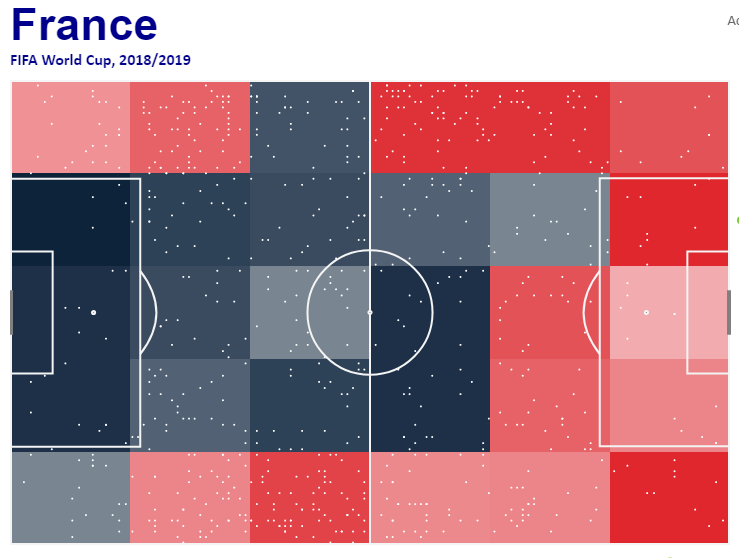As the World Cup heads to the knockout rounds there are three teams that remain head and shoulders above everybody else. Brazil, France and Spain remain the most likely teams to walk away champions, but each are doing it in a fairly unique way.
The Swashbuckling Attackers
Although Spain’s names remain largely the same, and the team’s reliance on an overabundance of skilled midfielders hasn’t changed, this isn’t your slightly older sister’s Spain. Gone are the days when Spain strangled matches with defensive possession and carefully built just enough well-constructed attacks to put teams to the sword. This Spain is considerably different. Spain’s attack is fantastic. During the group stage, against three relatively strong defensive teams in Portugal, Morocco and Iran, Spain dominated. They managed to both create a high number of shots and create really really good chances. They took 16 shots per game, the fourth most of any team in the group stages, which is a good number on it's own, but it’s absolutely fantastic when combined with their 0.14 expected goals per shot, the highest of any team in the tournament. 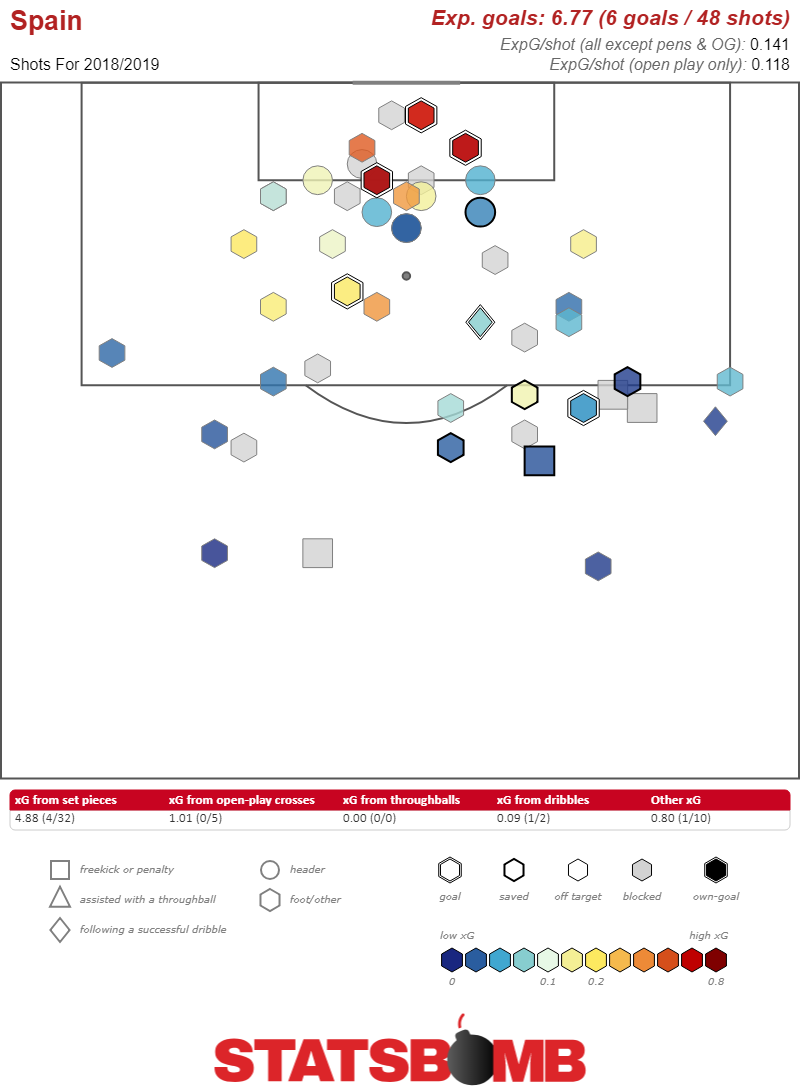 Fascinatingly Spain are no longer the impossibly patient attacking team that the world has become accustomed to. The addition of Diego Costa up front combined with some more attacking thrust from Isco has ended up seeing Spain progress the ball much faster (with a little bit of encouragement from Morocco’s pressing style mixed in). Only 13 teams in the group stage played at a faster pace (moved the ball forward faster before taking a shot) than Spain. The team has done an incredibly job of getting high quality non-headed shots from point blank range, in part because of their set play execution. Diego Costa, Iago Aspas and Isco (from a throw-in) all scored after getting the ball delivered to their feet in murderously good position. It’s hard to contend with a team that’s that well equipped to pick apart a defense. If Spain have a weakness it’s that their back line is shakier than it has been in recent memory. While they haven’t conceded a ton of shots this tournament, 7.67 per game is the fourth fewest of the 32 teams, they’ve been decidedly mediocre about conceding good shots. The 0.09 xg/per shot that they’re giving up is pretty average, and 12 teams are stingier. That’s not bad, per se, being a stingy team in terms of conceding shots while also being a behemoth in attack is certainly one way to win. It’s just not the way Spain has done it for the last decade. The Dogged Defenders N’Golo Kante is quite possibly the best defensive player in the world, and France, carried by the midfield superstar, have been the best defensive team at the tournament. They are not conceding shots, seven per match is behind only Uruguay in the tournament and also not conceding good shots, 0.03 xG/shot conceded is the second lowest in the tournament. While Didier Deschamps decision to start Blaise Matuidi in an advanced position against Peru was extremely conservative, it certainly worked as intended. Matuidi shut down the left side of the pitch, and strangled Peru.
Fascinatingly Spain are no longer the impossibly patient attacking team that the world has become accustomed to. The addition of Diego Costa up front combined with some more attacking thrust from Isco has ended up seeing Spain progress the ball much faster (with a little bit of encouragement from Morocco’s pressing style mixed in). Only 13 teams in the group stage played at a faster pace (moved the ball forward faster before taking a shot) than Spain. The team has done an incredibly job of getting high quality non-headed shots from point blank range, in part because of their set play execution. Diego Costa, Iago Aspas and Isco (from a throw-in) all scored after getting the ball delivered to their feet in murderously good position. It’s hard to contend with a team that’s that well equipped to pick apart a defense. If Spain have a weakness it’s that their back line is shakier than it has been in recent memory. While they haven’t conceded a ton of shots this tournament, 7.67 per game is the fourth fewest of the 32 teams, they’ve been decidedly mediocre about conceding good shots. The 0.09 xg/per shot that they’re giving up is pretty average, and 12 teams are stingier. That’s not bad, per se, being a stingy team in terms of conceding shots while also being a behemoth in attack is certainly one way to win. It’s just not the way Spain has done it for the last decade. The Dogged Defenders N’Golo Kante is quite possibly the best defensive player in the world, and France, carried by the midfield superstar, have been the best defensive team at the tournament. They are not conceding shots, seven per match is behind only Uruguay in the tournament and also not conceding good shots, 0.03 xG/shot conceded is the second lowest in the tournament. While Didier Deschamps decision to start Blaise Matuidi in an advanced position against Peru was extremely conservative, it certainly worked as intended. Matuidi shut down the left side of the pitch, and strangled Peru. 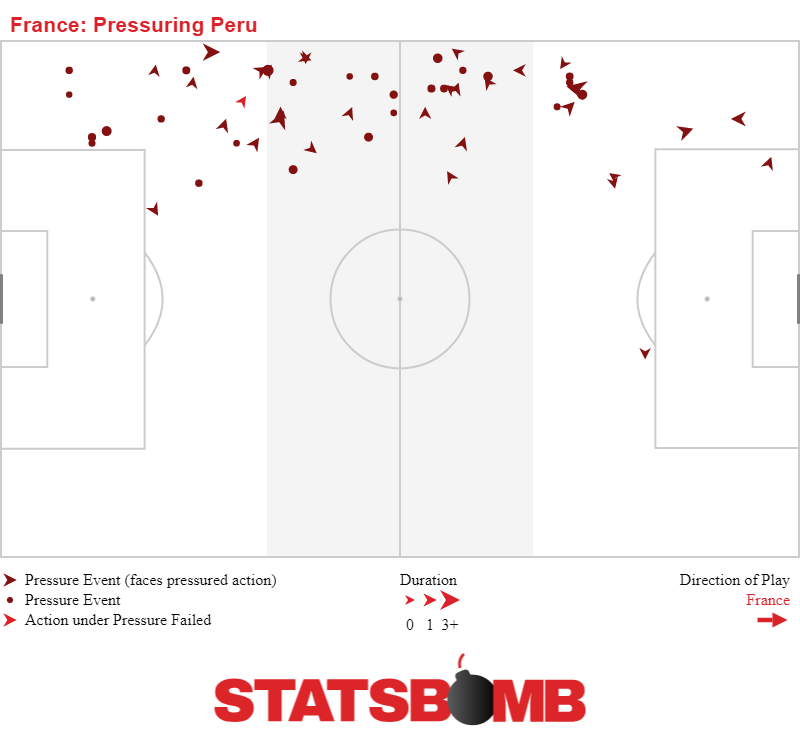 In general France have done an excellent job at pressuring opponents all over the pitch, it’s not pretty but it entirely shutting the field down. Combine Kante in midfield with a defensive presence like Matuidi ahead of him, add in a conservative set of fullbacks and you get a France team which barely lets the ball into the middle third of the field, much less into their own defensive territory. It may not be pretty, but it’s effective.
In general France have done an excellent job at pressuring opponents all over the pitch, it’s not pretty but it entirely shutting the field down. Combine Kante in midfield with a defensive presence like Matuidi ahead of him, add in a conservative set of fullbacks and you get a France team which barely lets the ball into the middle third of the field, much less into their own defensive territory. It may not be pretty, but it’s effective. 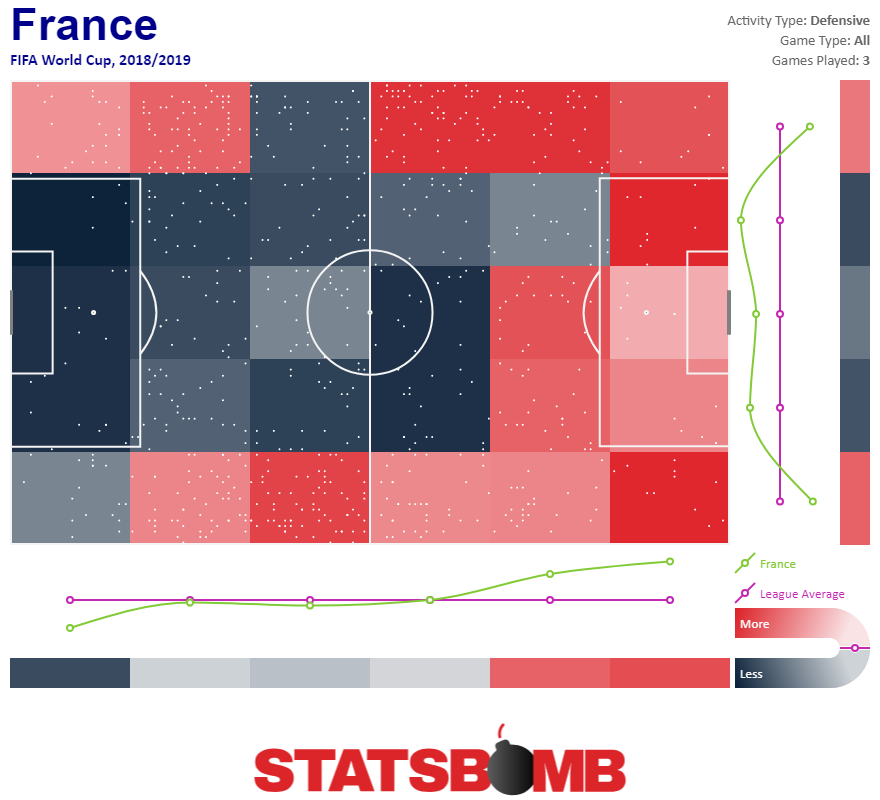 France are frustrating. Rather than leverage Kante’s defensive skills to give more freedom to the rest of the team, they’ve chosen to reinforce them. That shackles a lot of their most creative attacking players. Paul Pogba is often restricted from getting forward into dangerous areas (although he’s still managed to play an integral part in three goals for France), and the fullbacks are often held more in reserve than many modern teams. Antoine Griezmann and Kylian Mbappe are left to fend for themselves rather than feed off of a supremely talented supporting cast. Also, one of the preferred fullbacks has been Lucas Hernandez who is basically a center back. That perfectly understandable frustration shouldn’t obscure the fact that the strategy is working so far. France has been a dominant defensive team. And while it’s tempting to suggest that this defensiveness won’t hold up against better opposition, at least for the next two rounds they don’t have that much to worry about. In the round of 16 they take on Argentina who struggled to create against the likes of Iceland and Nigeria, and then they get the winner of Portugal and Uruguay, two teams that despite their potent forwards, focus on playing strong, positionally sound, defense. France are set up to grind their way deep into the tournament. They’ve made their tactical bed and they’re happy to lie in it. Kante, supported by a cadre of defensive first players build a fortress, then the attackers tack on just enough to get the job done. The Balance of Brazil If Spain are the most attack oriented favorite and France are the defensive side, then Brazil is the team that seems to have the balance just right. Defensively they’re conceding 0.50 xG per game, behind only France and Uruguay. That breaks down into conceding the fourth fewest shots at 7.33 and the fourth lowest xG/shot conceded at 0.07. On the attacking side of the ball their profile is a volume based one. They took 19.67 shots a game which was behind only the dearly departed Germany, and had a fairly average 0.10 xG/per shot which trailed twelve teams. Though put it all together and you get 2.01 xG per game which is the third highest in the tournament. Brazil’s numbers are almost certainly colored by just how extremely they had to chase the game against Costa Rica. After drawing against Switzerland in the first match, Brazil’s tournament life was flashing before their eyes as the CONCACAF side put in a dogged first half performance. But, at halftime you can see the flip switch, and at the hour mark they completely took over, even though the goal didn’t come until injury time.
France are frustrating. Rather than leverage Kante’s defensive skills to give more freedom to the rest of the team, they’ve chosen to reinforce them. That shackles a lot of their most creative attacking players. Paul Pogba is often restricted from getting forward into dangerous areas (although he’s still managed to play an integral part in three goals for France), and the fullbacks are often held more in reserve than many modern teams. Antoine Griezmann and Kylian Mbappe are left to fend for themselves rather than feed off of a supremely talented supporting cast. Also, one of the preferred fullbacks has been Lucas Hernandez who is basically a center back. That perfectly understandable frustration shouldn’t obscure the fact that the strategy is working so far. France has been a dominant defensive team. And while it’s tempting to suggest that this defensiveness won’t hold up against better opposition, at least for the next two rounds they don’t have that much to worry about. In the round of 16 they take on Argentina who struggled to create against the likes of Iceland and Nigeria, and then they get the winner of Portugal and Uruguay, two teams that despite their potent forwards, focus on playing strong, positionally sound, defense. France are set up to grind their way deep into the tournament. They’ve made their tactical bed and they’re happy to lie in it. Kante, supported by a cadre of defensive first players build a fortress, then the attackers tack on just enough to get the job done. The Balance of Brazil If Spain are the most attack oriented favorite and France are the defensive side, then Brazil is the team that seems to have the balance just right. Defensively they’re conceding 0.50 xG per game, behind only France and Uruguay. That breaks down into conceding the fourth fewest shots at 7.33 and the fourth lowest xG/shot conceded at 0.07. On the attacking side of the ball their profile is a volume based one. They took 19.67 shots a game which was behind only the dearly departed Germany, and had a fairly average 0.10 xG/per shot which trailed twelve teams. Though put it all together and you get 2.01 xG per game which is the third highest in the tournament. Brazil’s numbers are almost certainly colored by just how extremely they had to chase the game against Costa Rica. After drawing against Switzerland in the first match, Brazil’s tournament life was flashing before their eyes as the CONCACAF side put in a dogged first half performance. But, at halftime you can see the flip switch, and at the hour mark they completely took over, even though the goal didn’t come until injury time. 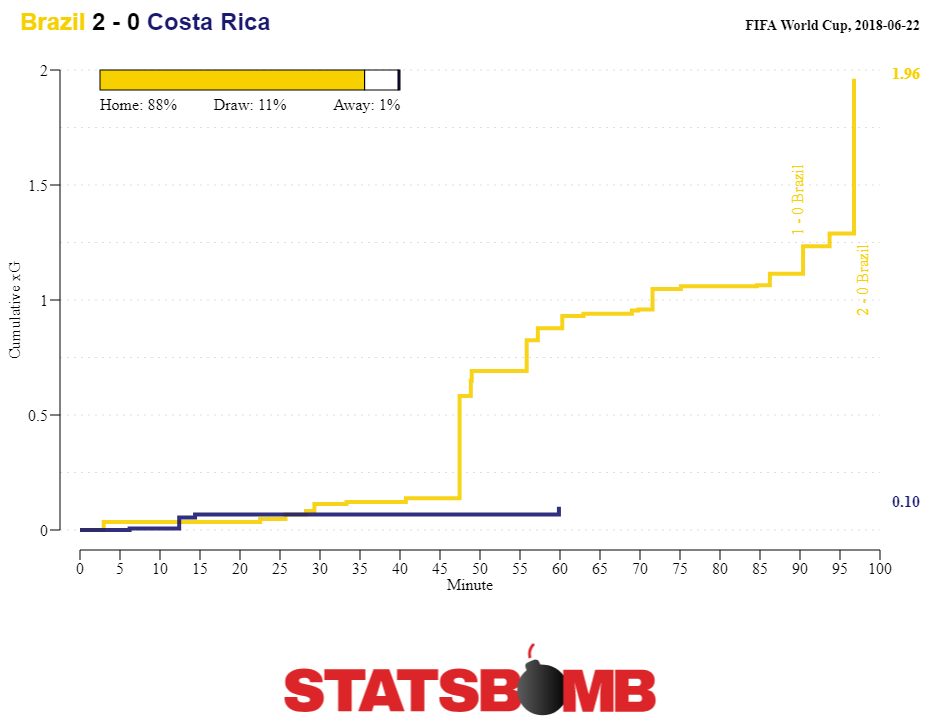 While Brazil are well balanced between defense and attack, they aren’t particularly well balanced across the field. The presence of Neymar on the left wing colors everything that the team does. The effect is exaggerated by Coutinho playing on the left of the midfield trio as well.
While Brazil are well balanced between defense and attack, they aren’t particularly well balanced across the field. The presence of Neymar on the left wing colors everything that the team does. The effect is exaggerated by Coutinho playing on the left of the midfield trio as well. 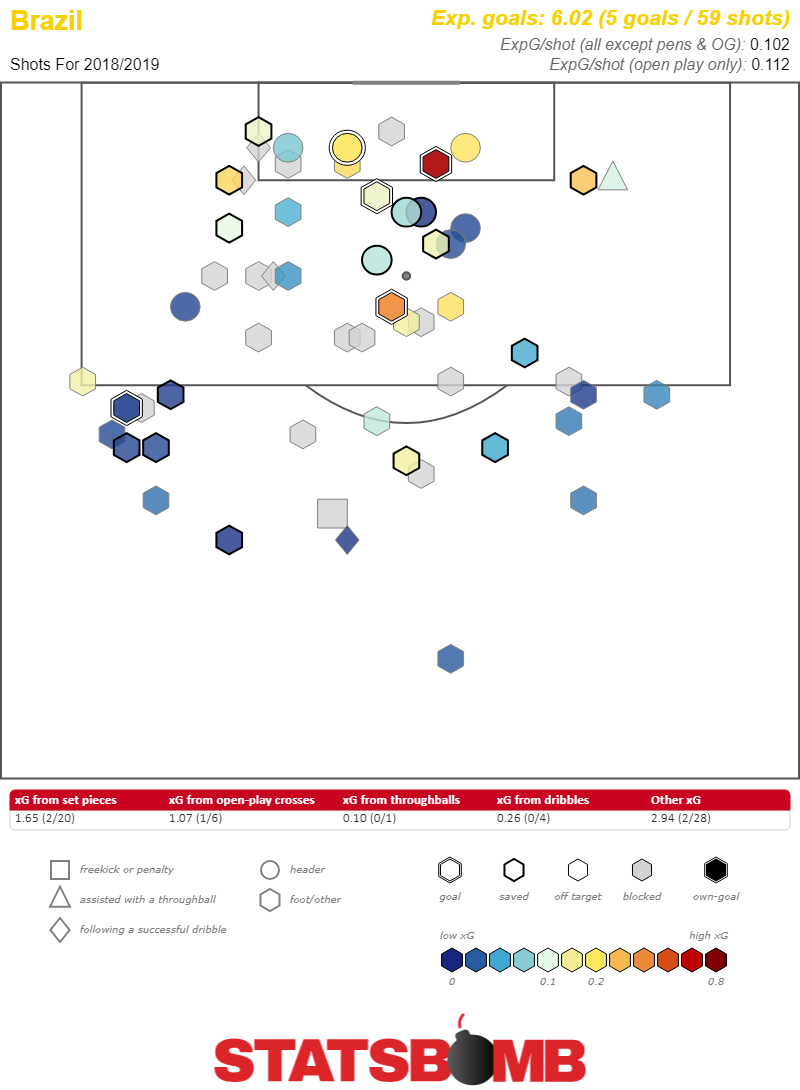 An outsized chunk of Brazil’s attack is currently coming from the right feet of those two stars. It’s a precarious balance to walk. Neymar is Brazil’s best attacker, and Coutinho has already scored twice this tournament. But, as Brazil gets deeper, if they start to hit better defensive teams, their overreliance on such a specific parcel of real estate could become a concern. For now though, they’ve been excellent on both sides of the ball, and despite having a difficult time breaking finally breaking through against Switzerland and then Costa Rica, remain the favorite to win the whole thing.
An outsized chunk of Brazil’s attack is currently coming from the right feet of those two stars. It’s a precarious balance to walk. Neymar is Brazil’s best attacker, and Coutinho has already scored twice this tournament. But, as Brazil gets deeper, if they start to hit better defensive teams, their overreliance on such a specific parcel of real estate could become a concern. For now though, they’ve been excellent on both sides of the ball, and despite having a difficult time breaking finally breaking through against Switzerland and then Costa Rica, remain the favorite to win the whole thing.
